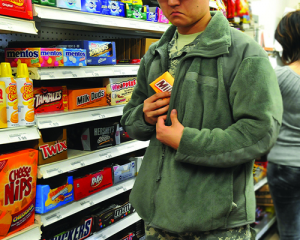5 steps to crack down on shoplifting

If you've been in retailing for more than a few weeks, you know that shoplifting is a fact of life. What you may not know, however, is how widespread shoplifting is and the impact it has on retailers, regardless of their size or what they sell.
Some retailers have been unwilling to take action against shoplifters due to a certain level of acceptance that shoplifting is just a part of the cost of doing business, but more and more retailers are fighting back. By employing a combination of good retailing practices, improved staffing policies, technology improvements, and partnerships with law enforcement, these retailers are reducing the opportunity to shoplift.
With that in mind, here are five steps to help convenience store operators crack down on shoplifting:
1. IMPROVE STORE LAYOUT & DISPLAYS
Improving store layouts and displays will make it easier for employees to monitor what's happening in the store and what customers are up to. This can be accomplished by reducing the number of exits and blind corners, carefully placing mirrors, and providing good, even lighting. To the extent possible, place goods away from store entrances and create clear sight lines in aisles by eliminating clutter and reducing the height of displays.
2. UPGRADE SECURITY MEASURES
This means more than just hiring security guards. Convenience store operators can also adopt policies that will impact shoplifting, such as restricting the number of unaccompanied minors allowed in the store and requiring proof of purchase for refunds. Encouraging shoppers to use supermarket-style baskets for purchases removes the excuse for putting items in shoppers' own bags. Keeping high-value items in locked displays and sealing the bags of legitimate purchases can reduce impulse theft.
3. HIRE MORE BETTER-TRAINED STAFF
This can help to inhibit shoplifting, although it may not be feasible for small store operators. Where possible, though, having more staff available to assist customers means a stronger retailer presence throughout the store and greater opportunities to surveil customers.
Training staff in procedures for dealing with shoplifting incidents can also help sustain a prosecution. For example, because retailers need to prove that stolen goods were not just taken away, but there was intent to avoid payment, trained staffers will know they should wait until suspects have left the store before apprehending them. Otherwise, shoplifters can simply claim they intended to pay before leaving.
4. USE ADVANCED TECHNOLOGY
Using advanced technology, specifically facial recognition software, has become a viable tool for targeting shoplifters, as costs have dropped and the technology has improved. Using image processing and machine learning algorithms to match a photo of an unidentified person against a database of photos of identified persons who previously have been arrested for shoplifting or other crimes, the software produces a list of possible matches, with each match having a score that indicates the quality or likelihood of a match. The police then use that list to either rule out or further investigate each match, just as they would with any other investigative lead.
Facial recognition software has risen in popularity as shoplifters have become increasingly sophisticated. Professional shoplifters who steal solely for resale or profit now comprise 10% of the total dollar losses due to shoplifting. These professionals include hardened criminals who steal as a lifestyle, international shoplifting gangs who steal for profit, and drug addicts who steal to feed their habits.
5. FORM PARTNERSHIPS WITH LAW ENFORCEMENT
For retailers, this has proven to be a highly effective means of cracking down on shoplifters, particularly in those instances where retailers are dealing with gangs of organized shoplifters.
While these steps won't stop shoplifting, they can go a long way toward helping your store avoid becoming another statistic in the battle to stem this alarming problem.
Column by Nick Coult, a senior vice president for law enforcement and public safety at Numerica Corp. He is one of the creators of Lumen, a platform for law enforcement search, analysis, and data sharing.
Originally published at Convenience Store News.
